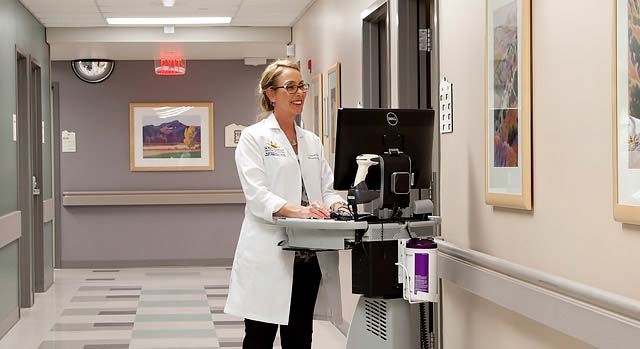Weight-loss Surgeries
The Bariatric Center at Southwest Healthcare Inland Valley Hospital offers several weight-loss surgical procedures, including:
Gastric Sleeve
Also known as vertical sleeve gastrectomy, this innovative procedure is often chosen by potential weight-loss patients because it has fewer long-term risks and doesn't require any foreign objects to be placed inside the body. In this procedure, the surgeon removes part of the patient's stomach to create a long, slender sleeve shape.
Out-of-town patients also favor this procedure because of the minimal follow-up care required. Patients undergoing the sleeve procedure can typically expect a two-night stay in the hospital and the ability to return to a normal routine within one week of surgery. Sleeve patients who practice the principles of behavior change can expect, on average, to lose 60-70 percent of excess weight within two years of the surgery. Additionally, patients tend to have fewer long-term risks such as ulcers, hernias and nutritional deficiencies.
Gastric Bypass
In this procedure, the surgeon staples across the top portion of the stomach to create a very small stomach pouch. The surgeon then connects the new stomach pouch to the small intestine, bypassing some of the upper and more absorptive part of the small intestine. This reduces the amount of food eaten as well as decreases absorption of the food and calories consumed. Results vary but the average patient usually can expect to lose 50 to 90 percent of excess weight in 12 to 18 months after surgery.
Laparoscopic Adjustable Gastric Band
Gastric band surgeons use a silicone band to create a small pouch using the top part of the existing stomach. Using thin surgical instruments and a small internal camera to monitor the operation, the surgeon places a silicone band around the top portion of the stomach creating a small pouch, without cutting or stapling. This pouch later limits the patient's food consumption without disrupting the normal progression of food through the digestive tract. In some cases, the gastric band is connected via a small tube to a small reservoir that contains saline. This reservoir is placed under the skin of the upper abdomen. After surgery, the surgeon will examine the patient to ensure that the band contains enough saline. It needs to be tight enough to allow for gradual weight loss while ensuring that the patient eats enough food for proper nutrition.
Adjustments typically are made to the band one month after the procedure. Using a fine needle, the surgeon can add or remove saline to enlarge or shrink the band. This results in allowing more or less food to pass between the two parts of the stomach. The number of adjustments varies from person to person, but most patients usually need three to five before the band is at the ideal tightness. This procedure allows for pregnancy since the stomach outlet size can be opened to increase nutritional uptake. With the gastric band procedure, patients can experience weight loss of one to three pounds a week in the first year after surgery. The amount usually decreases after 12 to 18 months.

